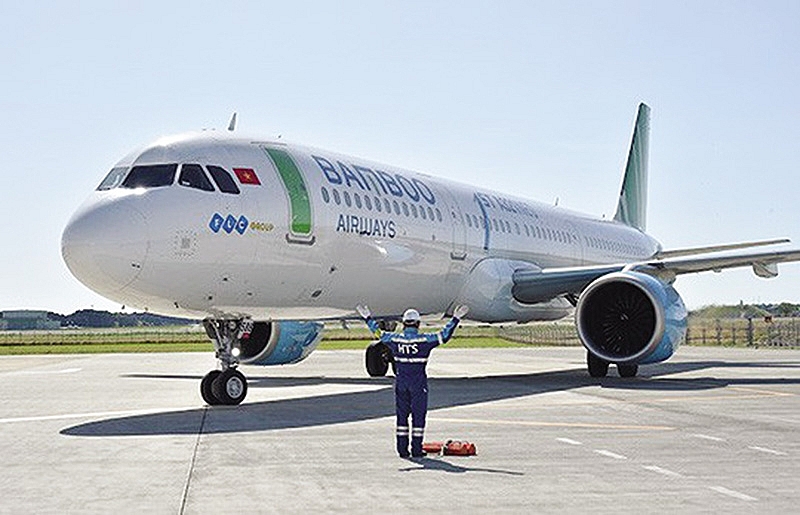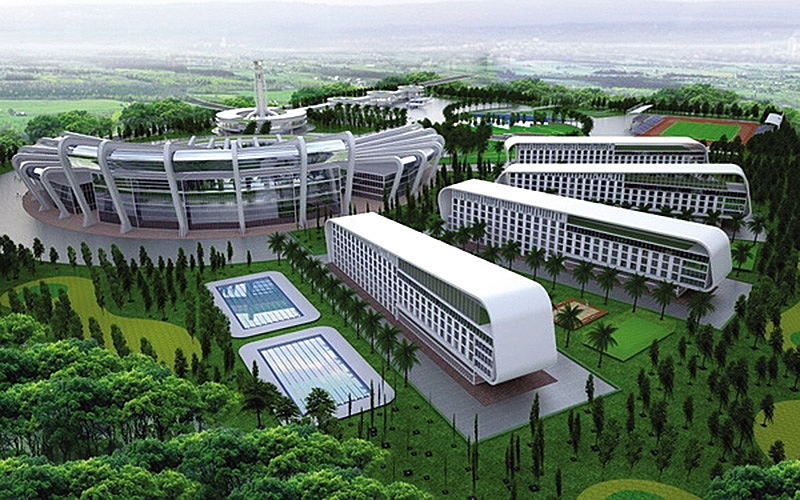Bamboo Airways sets up training centre
 |
| Putting Boeing 787 Dreamliner into operation |
In an interview with VIR, Dang Tat Thang, standing vice chairman of Bamboo Airways’ Board of Management, said that Bamboo Airways Aviation Training Institute would commence construction this month in the planning area of the Human Resources Research and Training Centre of core zone of Nhon Hoi Ecotourism Urban Area in the central province of Binh Dinh.
On June 19, 2019, the Binh Dinh People’s Committee issued Decision No.2072/QD-UBND officially approving the investment policy for the Bamboo Airways Aviation Training Institute.
International standard training
Covering 10 hectares of land, the institute has total investment of nearly VND700 billion ($30.43 million) for establishment and development. It is expected that after going into operation in the first quarter of 2022, the institute will train nearly 3,500 students per year, focusing on professional skills for pilots, flight attendants, aviation technology, ground operations, and basic training.
The institute will co-operate with FLC University to undertake specialised training such as transport management, international aviation operation, airport and flight operation management, marketing management, and air advertising.
Besides, the institute will co-operate with New Zealand Airline Academy – one of the country’s prestigious institutions offering leading education in the extremely developed air travel industry of the Oceania continent – to train pilots according to international standards.
Critical strategy
The first half of 2019 marked FLC Group’s entry into the field of education and training. In early June, the prime minister approved the project to establish FLC University.
Developing in the model of a non-profit private university, FLC University is built on an expected scale of about 50ha in Ha Lam and Ha Trung wards of Halong city in the northeastern province of Quang Ninh, with the total estimated investment of nearly VND4 trillion ($173.91 million).
With three key majors including high technology, tourism, and aviation, the university expects to welcome the first year of students at the end of 2020 with an initial capacity of 600 students, which will increase to 6,100 by 2024 and 10,000 by 2035.
The tie-up between Bamboo Airways and FLC University will help alleviate the shortage of aviation personnel which is a pressing issue brought up by many specialised conferences and forums.
According to the Vietnam Aviation Department’s (VAD) calculations, Vietnam will need 250 aircraft and about 200 pilots a year to meet the development demand in the segment in 2020-2030. However, pilot training centres in Vietnam currently meet only a small part of this demand, and most personnel have to be trained abroad at a rather high cost while resources are limited, and especially, the country is unable to take the initiative in human resources.
“Therefore, the establishment of a basic pilot training centre in Vietnam is necessary and it is also a critical strategy for the civil aviation industry in the current period,” said a VAD representative.
 |
| FLC University will assist Bamboo Airways in providing specialised training |
Taking initiative in human resources
According to surveys, pilots are still in the “most desirable” income group in the labour market, as new private airlines like Bamboo Airways or Vietjet are willing to pay pilots with an average salary of up to VND200 million ($8,700) per month.
However, to become a pilot at basic level, students have to overcome rigorous testing rounds of fitness, health, skill, and education, then complete training courses with an estimated cost of hundreds of thousands of US dollars. Then, they will have to attend courses at prestigious training schools around the world to obtain an international pilot license.
“Students will save about 10-15 per cent of the cost if they are fully trained in Vietnam,” said Ho Thi Thu Trang, human resources director of Bamboo Airways and deputy director of the Bamboo Airways Aviation Training Institute.
Trang said that Bamboo Airways’ main source of pilots currently comes from abroad. They are professionally trained with profound practical flight experience. However, the cost of recruiting such personnel is higher than that of domestic pilots. Therefore, this strategic investment of Bamboo Airways will help balance operating costs for the airline in its early stages of development.
More importantly, Trang affirmed that on-site training is the overall plan that Bamboo Airways chose to take the initiative in human resources development.
“After it is put into operation, the institute will increase the localisation rate of industry personnel, reducing dependence on foreign partners, improving industry competitiveness, as well as ensuring the sustainable growth of the Vietnamese aviation industry,” she emphasised.
Boeing 787 Dreamliners taking off
The establishment of the Bamboo Airways Aviation Training Institute will help consolidate human resources to serve Bamboo Airways’ plan to expand its network and fleet in 2019.
Accordingly, Bamboo Airways plans to exploit 37-40 domestic and international routes this year. Particularly in April, the airline has put into operation three routes to South Korea, Taiwan, and Japan.
The company also launched a branch in South Korea in May, and the next one will be in Japan this month. This will serve as the premise for building an international agency system serving commercial activities on regular routes connecting Vietnam with countries in Southeast Asia and Northeast Asia in particular, and across the globe.
Simultaneously, the company is accelerating the completion of its fleet to be in line with international standards, with the target of reaching more than 30 aircraft in total by 2023, including Airbus A321neo and Boeing 787 Dreamliner models.
According to Thang, Boeing is currently completing the assembly of Boeing 787-9 Dreamliners in accordance with the roadmap agreed by the two sides, and the first wide-body aircraft are expected to be handed over to Bamboo Airways in the fourth quarter of 2020.
“This is a new wide-body airliner line with modern technology, optimal performance, and stable operation, which is ideal for the medium and long-range flights of the Airline in the coming time,” said the representative of Bamboo Airways.
At first, to serve its operation, Bamboo Airways is leasing airliners from partners, preparing to put Boeing 787–8 Dreamliners into operation in the fourth quarter of this year.
Thang said that Bamboo Airways has carried out nearly 10,000 absolutely safe flights in six months of operation with an average load factor of 90 per cent and an on-time performance (OTP) rate of approximately 95 per cent.
According to new statistics published by the VAD, Bamboo Airways was the country’s most punctual airline in the first five months of the year.
Welcoming the peak summer tourism season, Bamboo Airways has increased the number of flights to appealing tourist spots, such as the routes connecting Hanoi with Quy Nhon, Danang, and Ho Chi Minh City, and opened the new Ho Chi Minh-Haiphong, Haiphong-Quy Nhon, and Haiphong-Nha Trang flights. In 2019, the company aims to increase the frequency of operations to 100 flights per day and serve five million passengers.
What the stars mean:
★ Poor ★ ★ Promising ★★★ Good ★★★★ Very good ★★★★★ Exceptional
Related Contents
Latest News
More News
- Businesses ramp up production as year-end orders surge (December 30, 2025 | 10:05)
- Vietjet chairwoman awarded Labour Hero title (December 29, 2025 | 13:06)
- How to unlock ESG value through green innovation (December 29, 2025 | 10:03)
- AI reshapes media and advertising industry (December 29, 2025 | 08:33)
- FPT and GELEX sign deal to develop blockchain tech for global markets (December 29, 2025 | 08:29)
- Vietnam’s GDP forecast to grow by 9 per cent in 2026 (December 29, 2025 | 08:29)
- Women entrepreneurs are key to Vietnam’s economic growth (December 29, 2025 | 08:00)
- Vietnam's top 500 value-creating enterprises announced (December 27, 2025 | 08:00)
- The PAN Group shaping a better future with ESG strategy (December 26, 2025 | 09:00)
- Masan Consumer officially lists on HSX, marking the next phase of value creation (December 25, 2025 | 13:20)

 Tag:
Tag:




















 Mobile Version
Mobile Version